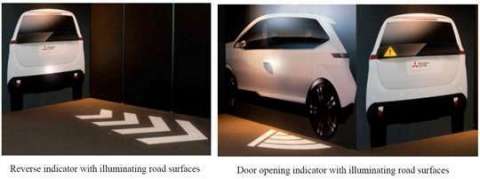Mitsubishi Introduces Signaling System to Indicate Vehicle Movement
Mitsubishi Electric, a leading manufacturer of in-vehicle entertainment, navigation systems, and advanced driver-assistance systems (ADAS) technologies, announced that its Safe and Secure Lighting system, which is currently in development, uses road-surface projections and car-body displays to alert pedestrians, cyclists, and other vehicles about impending car movements.
The company expects to deliver the system for installation in new vehicles by 2020.
The Safe and Secure Lighting system projects illuminated symbols on the ground to indicate that a vehicle is about to back up or a door is about to open. It can be coupled with alerts displayed in the rear window to reinforce the message.
According to data from the National Highway Traffic Safety Administration (NHTSA) published earlier this month, traffic fatalities in America hit a seven-year high in 2015, with pedestrians and cyclists accounting for a disproportionate share of the alarming increase.
“Addressing road safety for people walking and biking has never been more important, particularly given the influx of nearly silent vehicles, such as electric cars and hybrids,” says Mark Rakoski, vice president of engineering at Mitsubishi Electric Automotive America. “But even vehicles with combustion engines pose a great risk to pedestrians and cyclists, especially considering the increase in people wearing headphones.”
The Safe and Secure Lighting system is based on the natural actions of drivers and passengers and does not need to be manually activated, thus ensuring adequate time for passersby and other vehicles to react to the signals.
The light-based nature of the indicators will also offer important automotive safety advantages.
According to NHTSA’s latest pedestrian research, 74 percent of pedestrian fatalities occur at night, so illuminated projections that are clearly visible in the dark are expected to help reduce traffic accidents.
Mr. Rakoski also sees great future potential for the signaling system as the automotive industry moves to autonomous cars. “The intentions of self-driving cars can be tricky for drivers in legacy cars to interpret since there is no driver in the other vehicle to observe and therefore no eye-to-eye contact,” he adds. “This is especially true for pedestrians or cyclists who rely heavily on facial cues or hand signals from the drivers of oncoming vehicles.”
Category: General Update, News, Safety











